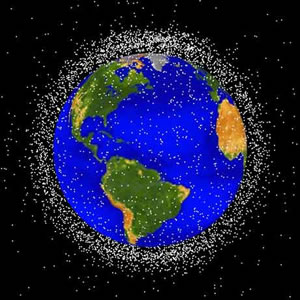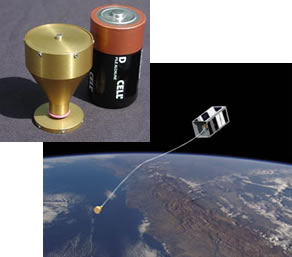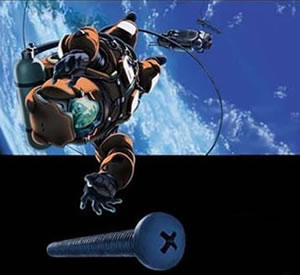Science Fiction
Dictionary
A B C D E F G H I J K L M N O P Q R S T U V W X Y Z
NanoTerminator Prevents Annoying Space Debris Build-Up

The nanoTerminator, recently released by TUI (Tethers Unlimited International), could help to prevent a rapidly growing problem in space - human-made debris from rockets and satellites. Although space is large (the volume of the known universe is about 1.9 x 10(33) cubic light years), space junk is a problem because it is concentrated right where we want to go - within a few hundred miles of the Earth's surface. Collisions with working spacecraft have already happened.

(NASA' actual space debris tracking)
These pieces of space debris range in size from flecks of paint and insulation to whole rocket stages and dead satellites. The greatest concentration of objects is found in the area between 550 miles and 625 miles above the Earth, above the orbits of the International Space Station and most shuttle flights. The US Space Surveillance Network tracks over 13,000 objects larger than ten centimeters.
The nanoTerminator™ is just 55 mm high and masses about 56 grams. It contains a 100-meter long space-survivable conducting tether and a simple spring-based deployment system. It can be integrated into a nanosat either externally or internally with an appropriate aperture for ejection. The module is designed to fit perfectly within the cylindrical ejection post of Ecliptic’s RocketPod CubeSat Plus.

(nanoTerminator on Earth and deployed in space)
When the satellite reaches the end of its operational phase, a release mechanism deploys the tether. Gravity gradient forces will orient the tether along the local vertical; the conducting tether will drag against the geomagnetic field, rapidly lowering the orbit of the nanosatellite until it burns up in the upper atmosphere.
Science fiction authors have thought about this for a long time. Arthur C. Clarke wrote about Operation Cleanup, required before the space elevator in his 1978 novel The Fountains of Paradise could be built. Read more about the Clarke connection (and more about how tethers work) in an earlier story about the Terminator Tether - EDT Solution To Space Debris.
Makoto Yukimura began publishing Planetes in Japan in 1999; the first graphic novel form was published in 2000. Planetes follows the story of a team of debris cleaners charged with clearing space junk from space flight paths.

Planetes cover art
The journal Science just published a new study about space debris; it starts with the simplifying assumption that no rocket bodies or spacecraft will be launched for the next two hundred years. Based on the data, it looks like new fragments from collisions will replace the population of objects that fall out of orbit and back to Earth. Beyond 2055, fragments from new collisions will actually cause the debris population to grow. We may need both nanoTerminators and space debris teams to clean up this problem.
Read Space Junk Cleanup and Space debris a growing problem; thanks to Fred Kiesche for writing in with the story and manga references.
Scroll down for more stories in the same category. (Story submitted 1/25/2006)
Follow this kind of news @Technovelgy.| Email | RSS | Blog It | Stumble | del.icio.us | Digg | Reddit |
Would
you like to contribute a story tip?
It's easy:
Get the URL of the story, and the related sf author, and add
it here.
Comment/Join discussion ( 2 )
Related News Stories - (" Space Tech ")
Will Space Stations Have Large Interior Spaces Again?
'They filed clumsily into the battleroom, like children in a swimming pool for the first time, clinging to the handholds along the side.' - Orson Scott Card, 1985.
Reflect Orbital Offers 'Sunlight on Demand' And Light Pollution
'I don't have to tell you about the seven two-mile-diameter orbital mirrors...'
Chrysalis Generation Ship to Alpha Centauri
'This was their world, their planet —
this swift-traveling, yet seemingly moveless vessel.' - Nat Schachner, 1934
The First Space Warship For Space Force
'Each of the electrical ships carried about twenty men...' - Garrett P. Serviss, 1898.
Technovelgy (that's tech-novel-gee!) is devoted to the creative science inventions and ideas of sf authors. Look for the Invention Category that interests you, the Glossary, the Invention Timeline, or see what's New.
Science Fiction
Timeline
1600-1899
1900-1939
1940's 1950's
1960's 1970's
1980's 1990's
2000's 2010's
Current News
The Zapata Air Scooter Would Be Great In A Science Fiction Story
'Betty's slapdash style.'
Thermostabilized Wet Meat Product (NASA Prototype)
There are no orbiting Michelin stars. Yet.
Could Crystal Batteries Generate Power For Centuries?
'Power could be compressed thus into an inch-square cube of what looked like blue-white ice'
India Ponders Always-On Smartphone Location Tracking
'It is necessary... for your own protection.'
Amazon Will Send You Heinlein's Knockdown Cabin
'It's so light that you can set it up in five minutes by yourself...'
Is It Time To Forbid Human Driving?
'Heavy penalties... were to be applied to any one found driving manually-controlled machines.'
Replace The Smartphone With A Connected Edge Node For AI Inference
'Buy a Little Dingbat... electropen, wrist watch, pocketphone, pocket radio, billfold ... all in one.'
Artificial Skin For Robots Is Coming Right Along
'... an elastic, tinted material that had all the feel and appearance of human flesh and epidermis.'
Robot Guard Dog On Duty
I might also be thinking of K-9 from Doctor Who.
Wearable Artificial Fabric Muscles
'It is remarkable that the long leverages of their machines are in most cases actuated by a sort of sham musculature...'
BrainBridge Concept Transplant Of Human Head Proposed
'Briquet’s head seemed to think that to find and attach a new body to her head was as easy as to fit and sew a new dress.'
Google's Nano Banana Pro Presents Handwritten Math Solutions
'...copy was turned out in a charming and entirely feminine handwriting.'
Edible Meat-Like Fungus Like Barbara Hambly's Slunch?
'It was almost unheard of for slunch to spread that fast...'
Sunday Robotics 'Memo' Bot Has Unique Training Glove
'He then started hand movements of definite pattern...'
Woman Marries Computer, Vonnegut's Dream Comes True
'Men are made of protoplasm... Lasts forever.'
Natural Gait With Prosthetic Connected To Nervous System
'The leg was to function, in a way, as a servo-mechanism operated by Larry’s brain...'
